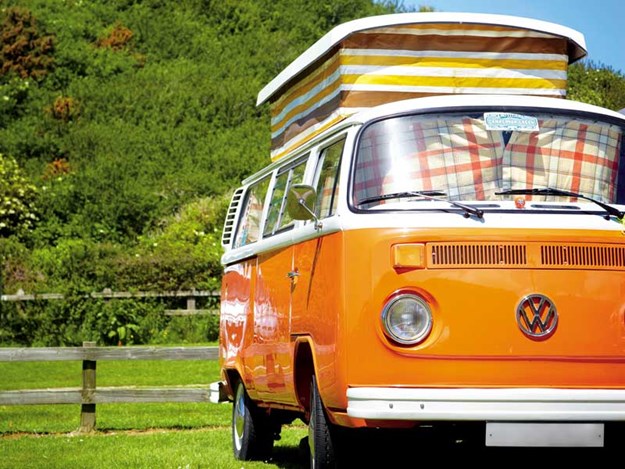When the first campervans took to the roads in the mid 20th century, no one would have envisaged the journey they would set alight. The modern styles and luxurious interiors of the motorhomes that have evolved 70 years since, would not have existed even in the imagination.
1950/60s
Of all the classic vehicles that have achieved cult status, the Volkswagen Kombi van reigns supreme. As campervans they have never lost their worldwide appeal since the ‘50s and ‘60s when they were an a-la-mode form of travel for hippies and young explorers.
Today, old vans with decrepit interiors and crumbling bones attract high prices and are snapped up to be rescued, restored, painted in bright coloured livery, and retrofitted with stylish interiors.
The camper craze came soon after VW launched the Kombi in 1950, and a German coachbuilding company called Westfalia began producing removeable (and later permanent) camping packages to fit inside them. Interior layouts were extremely varied. Not only did Westfalia have a wide range of layout conversions but many other companies throughout the world jumped on the ‘band van’ and began designing their own.
1970/80s
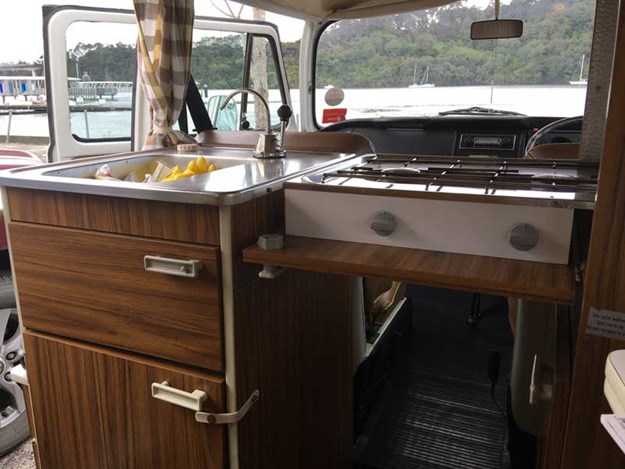 |
An original Westfalia fitted interior in an early Kombi camper van conversion |
My first motorhome rally was in 1981, at the infamous Nambassa Festival in Waihi. In New Zealand the hippie counterculture and the craze of hand-crafted house trucks had been in vogue since the 1970s.
At Nambassa I found an irresistible mix of exuberance and rebellion, not only in the revellers’ behaviour but in the hundreds of innovative rigs with exteriors and interiors that were as free flowing and varied as the lifestyle of their owners.
They were crafted from old buses and trucks with various degrees of expansions and enhancements. The DIY interiors were built on the cheap from recycled kauri, totara or rimu timber with workmanship varying from awful to superb.
The best of them flaunted elegantly crafted cabinetry and lavishly decorated home comforts. Pot belly stoves provided heating for cooking, hot water and warmth. Cook tops were run on kerosene and lighting was by gas lamp or candles Sadly, there are few of these weighty dinosaurs left on New Zealand roads.
1990-2010
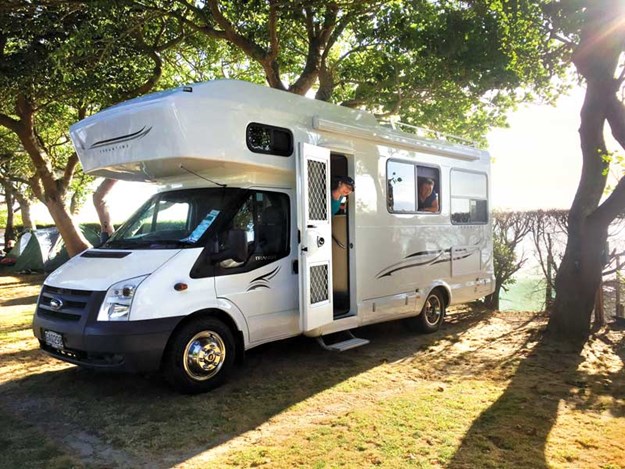 |
The Dreamtime model, by KEA |
The trend in DIY mobile homes, however, was not ready to disappear. Enthusiasts throughout New Zealand bought up second-hand buses from Japan such as Hino Rainbow, Mitsubishi Rosa and Nissan Civilian. Turning the interior of a tired bus into a liveable mobile home became as much part of the journey as being on the road.
The new wave of conversions was much advanced on its bohemian predecessors with well-equipped kitchens, roomy showers, bathrooms, water tanks, TVs, gas or diesel heaters, hot water, and inverters to run appliances. It was also the early days of energy by way of solar panelling. Interior décor did not follow any sort of trend, reflecting instead the whims and preferences of the owners.
The age of self-converted buses faded quickly when EU (Euro 1) emission standards were adopted here in 1997 and the importation of second-hand buses was no longer feasible. Commercial motorhomes, manufactured from the chassis up, began to dominate the market.
Ci Munro had been building motorhomes since the ‘70s but it took longer for other manufacturers to start down that road.
In the mid-1990s, New Zealand’s Wakerley brothers began building custom-built luxury motorhomes in Tauranga. They were elite affairs ranging from 6.4 to 12.2 metres in length and featuring design innovations such as beds that retracted into the ceiling, long slide-outs that could accommodate both kitchen and lounge, chic bathrooms arrangements, floor to ceiling pantries, solid timber leaf-drop dining tables, built-in computer stations, TVs in the lounge and bedroom and padded ceilings for noise reduction.
The cabinetry was made of solid rimu and teak timber emulating the best of boating design. Wakerley motorhomes were costly, but built to last, and even by today’s standards have lost none of their sophistication. Unfortunately, due to several external factors the company wound up in 2013.
Also established in the mid-90s, KEA Manufacturing broke boundaries by designing and fitting showers and toilets in their rental two-berths. As well as being robust, KEA interiors were superior in style and quality which made them popular purchases when they were on-sold after two years in the fleet.
Among the on-going KEA design innovations, the company launched the four berth, 6.8-metre Dreamtime in 2005, which, along with the six-berth Endeavour, was a triumph. The bathroom moved forward from mid-ships which gave space to a rear U-shaped lounge surrounded by picture windows. The settee made up to a large double bed or two singles and there was a spacious bed in the Luton. Felted Vertiface clad the walls, joinery was blonded beech, and upholstery in two-tone, suede-look macrofibre.
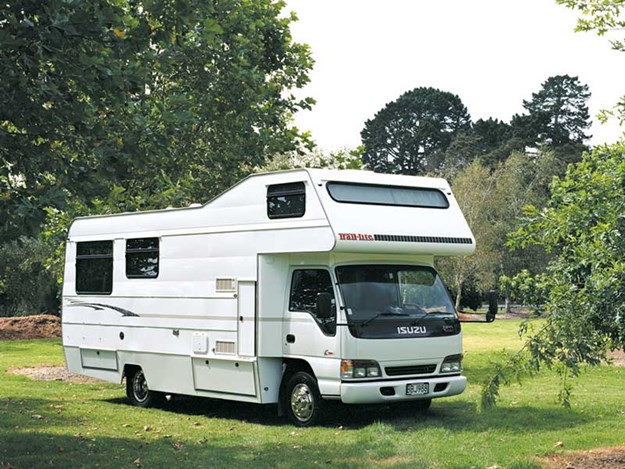 |
An early 2000’s model TrailLite motorohome |
TrailLite, already a well-known caravan manufacturer, had been building motorhomes since the late 1980s.
“It was a natural progression,” says Peter Newman, who is now the CEO of the company.
“We built them on 5.5 metre CF Bedfords, then on Daihatsus, Toyotas and Mazdas. Without turbo engines customers had plenty of time to enjoy the scenery.”
They were fitted with chemical portable toilets that lived under the wardrobe and were built on rails so they could slide out over the shower tray when in use. Beds were in the cabovers and the settees in the rear club lounge could also be converted into a bed. This layout was so popular it was the company’s mainstay for years. The kitchen was quite generous, and they were purpose-built for freedom camping with 160 litre water tanks, gas ovens, and Electrolux under-bench fridges.
“The fittings and furniture were in the same dark woodgrain finish we’d been using in caravans,” says Peter. “And then a customer came along and wanted a white painted interior with peach coloured cupboard doors. It looked fantastic and was a massive step away from wood grains. We built quite a few of them after that.
“We have kept our standards high and over the years our interiors have become even more sophisticated along with the latest trends. Customers choose their own upholstery and now pick their colour schemes in lacquer.”
As more accessories and products became available TrailLite, always ahead of the game, could see the popularity of European motorhomes and joined the next trend by adding imported vehicles to their range of products. It was a smart move as in the last ten years European (and other) manufacturers have added to the New Zealand motorhome market a bewildering array of possibilities in layout and aesthetics with smart use of space and clever integration of different features.
The traditional New Zealand motorhome layout was a rear U-shaped club lounge surrounded by large windows, and settees that converted to a double bed. European designs had smaller kitchen benches and windows with permanent beds and often a dinette.
Perhaps the most significant features though, were in the sleeping department with the advent of permanent island beds with west/east or north/south orientation and often a door that divided the bedroom from living areas. Drop-down ceiling beds have also gained favour.
Another design shift has been in the ablution areas. Bathrooms make the most of smaller spaces with nifty design innovations that divide showers from toilets and basins and have elegant fittings and ingeniously designed cupboard spaces.
Among other developments, window coverings incorporate separate pull-down blinds and insect screens, so that curtains have become more of a decorative feature. Ceiling hatches and windows have increased in size letting in more daylight and sometimes too much sun.
LED lighting has turned interiors into fun parlours, and knobs and pushbuttons have been outed for complex digital touch panels, some of which can almost tell you what you had for breakfast.
Beyond 2020
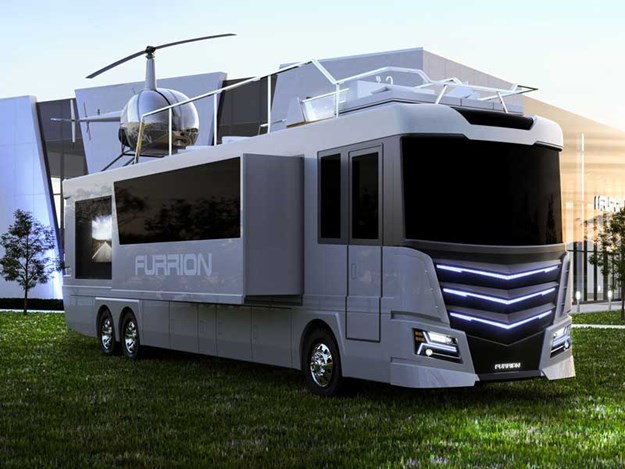 |
The futuristic Elysium from Furrion (not yet on NZ roads!) |
As we move into the new decade, motorhome design, inside and out, continues to evolve and the forward-looking developments of the past ten years are paving the way for smarter, more sumptuous motorhomes of every style size and layout. Some design concepts are wildly imaginative, but they contain elements that may well be incorporated into future vehicles.
The A-class Elysium concept is among the most extravagant. It has a yacht-like deck with a hot tub, sun loungers and an adjustable landing pad for a small helicopter. Inside the kitchen is designed for a culinary master class, there’s a 74-inch HDTV, a fireplace, a bathroom you could swing a small horse in and a price tag worthy of a space rocket.
Then there is a Hymer concept called Galileo, which is unlikely to see the
light of day, but explores what trekking across a continent might look like in the year 2030.
It is a very strange shape indeed and more like an apartment than a simple camper. Each customer personalises the floor plan and amenities package, and a team of human and robot workers prepare each pod to specification. This mind-blowing, boxy, glass-walled self-driving concept looks as if it should operate on the moon and if it’s ever built, probably will. More realistic is Hymer’s Vision Venture camper, built on the latest Mercedes Benz Sprinter.
The bed is stored in an insulated pneumatic pop-up roof, accessed by stairs. The van’s tailgate doubles as a balcony, so if you’ve reversed up to your scenic camping spot, there’s a safe ledge to sit on. Downstairs is a luxurious lounge, with large windows and a beautifully laid out kitchen and a retractable barbecue.
These imaginative ideas are propelling us into a sci fi world so far removed from the world we know, I might just roll up my tent. One of the greatest things about motorhoming is its simplicity. Well, it used to be! And in a world gone mad with complexity, the question now is, how much further will consumers want to go?
One of a kind
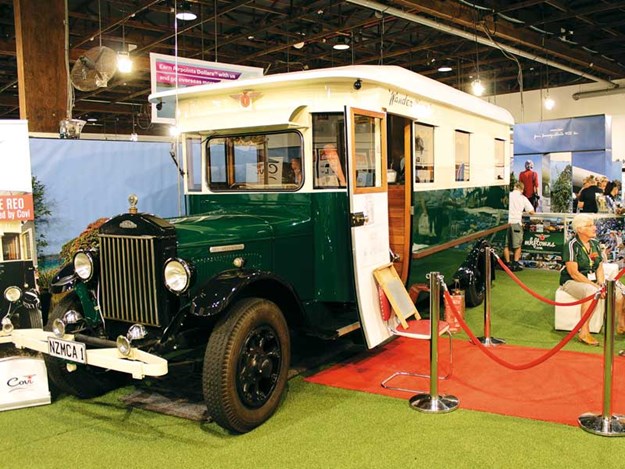 |
The NZMCA’s restored REO Speedwagon |
On the front cover of this issue of MCD is a magnificently restored 1928 REO Speed Wagon. It had been coach-built in Auckland and used as passenger and freight transport around Gisborne, later transporting workers to the Gisborne Freezing Works. The number plate reads NZMCA 1 which relates to the vehicle’s rather interesting history.
In the 1950s, it was bought by Gisborne locals, Gladys and Andy Anderson, who converted it to a motorhome. In 1956 they applied to join the local caravan club but were turned down because a converted bus didn’t fit the club’s criteria. Undaunted, this enterprising couple decided to start a club of their own, and so became the founders and first members of the New Zealand Motorhome Caravan Association (NZMCA). They could never have envisaged that their action would spawn a club that today has over 90,000 memberships.
The Anderson family enjoyed the REO for several years before selling it on. Much later it was spotted slowly disintegrating in a farm paddock near Tauranga by members of the Tauranga Historic Village Trust who rescued, restored and used it for passenger transport in the village before bequeathing it to the East Coast Museum of Technology.
It was in a terrible state by then and a few years ago, members of the NZMCA Eastland Area proposed to the NZMCA Board that what was left of the vehicle should be purchased and rebuilt. Many hours of labour and expertise have now restored this venerable motorhome to the splendid relic of the past that it is today.

